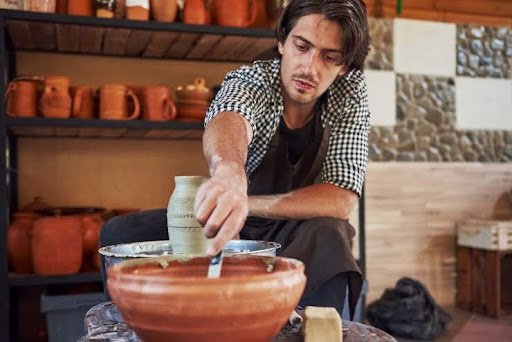Spin Your Way to Artistic Expression: A Pottery Wheel Primer

Pottery has been a cherished form of artistic expression for centuries, allowing creators to mold clay into unique shapes and forms. Among the various techniques, using a pottery wheel stands out as both traditional and versatile.
In this primer, we’ll delve into the art of pottery wheel throwing, exploring its techniques, tools, creative possibilities, troubleshooting common challenges, advanced techniques, and tips for setting up a pottery studio.
Getting Started: Understanding the Basics
The Pottery Wheel: A Brief Overview
The pottery wheel, also known as a tour de poterie, is a rotating device used to shape clay into vessels, sculptures, and other forms. Its origins date back to ancient Mesopotamia and Egypt, where it revolutionized ceramic production.
Essential Tools and Materials
Before diving into pottery wheel throwing, gather the necessary tools and materials:
- Clay: Choose a clay type suitable for wheel throwing, such as stoneware or porcelain.
- Pottery Wheel: Opt for an electric or kick wheel based on your preference and availability.
- Water and Sponge: Keep clay moist and facilitate shaping with water and a sponge.
- Pottery Tools: Have a range of tools like ribs, wire tools, and trimming tools for shaping and refining.
Mastering Techniques: Step-by-Step Guide
- Preparing the Clay: Begin by wedging the clay to remove air bubbles and ensure uniform consistency. Then, center the clay on the wheel head by applying pressure with your hands while the wheel is in motion.
- Centering: Centering is a fundamental skill that involves aligning the clay mass with the rotational axis of the wheel. Use gentle yet firm pressure to achieve a balanced clay mound.
- Pulling and Shaping: With the base established, begin pulling the clay upwards to create walls. Apply consistent pressure and control the wheel speed to achieve desired thickness and form.
- Smoothing and Finishing: After shaping the vessel, use a rib tool to smooth the surface and remove excess water. Pay attention to details and refine the form with trimming tools if necessary.
Exploring Creative Possibilities
- Functional Ware: Pottery wheel throwing offers endless possibilities for creating functional ware such as bowls, cups, and vases. Experiment with different shapes, sizes, and surface decorations to enhance usability and aesthetics.
- Sculptural Forms: Beyond functional ware, pottery wheel throwing can be used to create sculptural forms and artistic expressions. Explore abstract shapes, textures, and surface treatments to push the boundaries of traditional pottery.
- Surface Decoration Techniques: Enhance your pottery creations with various surface decoration techniques, including carving, sgraffito, and glazing. Experiment with different colors, patterns, and textures to add visual interest and depth.
Troubleshooting Common Challenges
Wobbling or Off-Center Forms
If your vessel wobbles or appears off-center, revisit the centering process and apply consistent pressure to achieve stability.
Cracking or Drying Too Quickly
To prevent cracking or drying too quickly, keep the clay moist by periodically spritzing it with water and covering it with plastic when not in use.
Uneven Thickness
Achieving uniform thickness in your pottery requires practice and attention to detail. Use calipers or your fingertips to gauge thickness and adjust accordingly while throwing.
Advanced Techniques and Tips
- Altering Forms: Once you’ve mastered the basics, challenge yourself with advanced techniques like altering forms. Experiment with techniques such as fluting, faceting, and adding coils or slabs to create unique shapes and textures.
- Throwing Larger Pieces: Throwing larger pieces presents its own set of challenges but opens up exciting possibilities for grander creations. Practice controlling the clay’s center of gravity and adjusting your throwing technique to accommodate larger masses of clay.
- Multi-Piece Assemblies: Explore the art of creating multi-piece assemblies by throwing separate components and joining them together. This technique allows for the creation of complex forms and multipart vessels, expanding your creative repertoire.
Finding Inspiration
Drawing Inspiration
Seek inspiration from various sources, including nature, art history, and contemporary ceramics. Visit museums, galleries, and pottery studios to study masterpieces and gain insight into different styles and techniques.
Continuing Education
Enroll in pottery classes, workshops, or online courses to further develop your skills and expand your knowledge base. Learning from experienced instructors and interacting with fellow ceramic artists can provide valuable feedback and support on your artistic journey.
Building a Pottery Studio
Setting Up Your Space
Consider setting up a dedicated pottery studio to fully immerse yourself in the creative process. Ensure adequate space for your pottery wheel, workbench, storage, and kiln, and prioritize ventilation and safety measures for a comfortable and functional workspace.
Investing in Equipment
Invest in quality pottery equipment, including a reliable pottery wheel, kiln, and assortment of tools and supplies. Research different brands and models to find equipment that meets your needs and budget, and don’t hesitate to seek advice from experienced potters.
Conclusion
Pottery wheel throwing offers endless opportunities for artistic exploration and self-expression, from mastering fundamental techniques to pushing the boundaries of creativity with advanced skills and experimentation.
By embracing the journey of learning, practicing, and refining your craft, you can spin your way to profound artistic expression and create pottery that reflects your unique vision and style. So, let the wheel spin, your hands mold, and your imagination soar as you embark on your pottery adventure.


